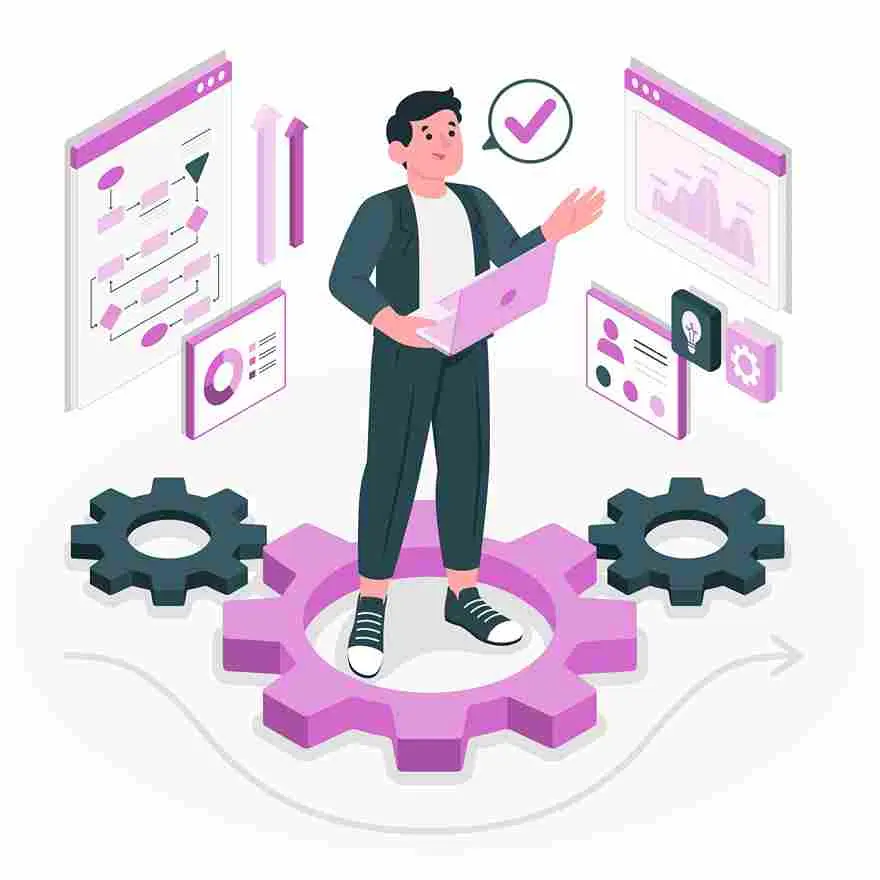Let’s investigate Product Lifecycle Management (PLM) and how product managers pull it off — not as boring as it sounds, I promise!
As the industries grow, the enterprise market competition rises ever higher, businesses striving to secure a competitive advantage and rank higher in the market, need to implement top product lifecycle management strategies to keep up with the pace.
First, we need to understand what PLM essentially means and then find out what the key steps and stages of PLM are and how can you navigate professionally through them.
Product Lifecycle Management: An Introduction
Understanding the fundamental definition and purposes of Product Lifecycle Management is necessary to move on with the process. PLM is the complete progress of fostering a blueprint idea and materializing it into the final product.
This includes designing, development, prototyping, delivery, launch, marketing, and sales. This complete process ensures the perfect product development.
Product Management/Product Development
It is crucial to identify the basic differences between Product Management and Product Development, as these two are separate terms.
The product management team oversees and supervises the entire product processes, even after the launch while product developers are the ones materializing the concept, building, and maintaining the functionality of the product.
Now, let’s go through the inevitable processes, stages, and steps that are involved in product lifecycle management:
Stage 1: Concept and Ideation
The product life begins here when it is just a vague idea in your team’s collective mind. The most fundamental stage is when you scrutinize the idea, brainstorm, make rough sketches, make estimates, and understand the purpose of the product, its function, and how it’s going to make an impact on your targeted industry.
Initiating the product process includes defining and keeping in view the ultimate requirements of your product. The goals that you need to achieve and the necessary stages that the product development must include. Starting more realistic and smaller can help you stay relevant and aligned with the market inclination.
Use tools like customer feedback and market analysis to get a grip on what’s needed. Don’t be the person who invents another unnecessary gadget nobody asked for.
Involve diverse teams early on. Get marketing, sales, and product development in on the action from day one. Because they’ll bring different perspectives and offer their expertise on what sells and what does not so you can avoid that awkward moment when your genius product idea turns out to be a nightmare to sell.

Read More:
Stage 2: Design the Prototype
Having gone through each of the critical aspects of the product, where you establish the concept, scope, and market trends, now is the time to realize your idea. But before the whole product development starts, you need to design a prototype, which is the minimalist functional unit of how the whole product will look or operate.
The design and development stage is where your idea turns into an actual, physical, or digital prototype.
A prototype is essentially the reflection of the final product without some non-essential features and focuses on the functionality and operational efficiency of the final product, creating a Minimum Viable Product (MVP).
The MVP is created to test the product with early adopters and how it would respond to various queries that are basic and comply with the core functionalities of the complete product. Consider it as a mockup, the prototype is what visualizes the real product for the end users.
Collecting feedback from the users can prove vital while finishing the actual product. It can minimize time and resource wastage and identify any lag, issues, bugs, or any major setback that can potentially reduce efficiency.
Collaboration tools are your best friend. Use platforms like CAD software or digital twins to simulate and optimize designs before you start burning money on prototypes.
Stage 3: Testing and Validation
Testing and validation can be considered seriously crucial steps of the development process. After designing the prototype you need to get it verified not just from the user but from the professional point of view.
The big idea here is to make sure the product complies with its core purposes and objectives and meets all quality and regulatory requirements. Here you verify not only the functionality but also the scope of your product. Collecting the feedback and user perspectives of the product prototype helps you get a clear picture of what the product will gain in the market and if the idea is worth completing or if you should drop the initiatives and rethink the entire product.
Best practices for this stage involve being thorough. Test the product in as many conditions as possible. Stress test it. Break it if you must. It’s better for it to fall apart in testing than in a customer’s hands. If the feedback isn’t stellar, you can fix it early on.
Keep the feedback loop open. Involve not just your engineers but also end-users or beta testers who can give you real-world insights. Sometimes they’ll spot issues that your team won’t even think of.
Stage 4: Delivery
After the initial development of the product, now is the time to lay all of the important groundwork for a successful product launch. This is the second last step that comes right before product launch and hence is crucial for ensuring that the product is aligned with the requirements and is functioning as expected.
This state concludes the entire chronology of a software product and product managers are responsible for seeing it through and making sure each stage is justified and validated.
Stage 5: Launch
The final stage is to launch your product in the market after considering all the necessary aspects and aligning with the marketing strategy, your product is good to reach its target audience. This is the exciting part, but don’t get too caught up in the hype. A smooth product launch requires some finesse and planning.
Plan your marketing strategy well in advance. Build up the hype through sneak peeks, social media teasers, and influencer partnerships. Your launch should feel like an event, not just another Tuesday. But also make sure your sales teams are fully equipped with all the knowledge they need to promote and sell your product effectively.
The Best Practices in PLM
1. Clear Objectives and Strategy
To ensure a successful software implementation, start with the purpose and requirement identification, then develop a strategy for procurement, implementation, and rollout. Focus on a single, measurable objective, whether it’s reducing development time, improving collaboration, minimizing errors, or enhancing product quality. This clarity helps in tracking progress and evaluating the software’s return on investment (ROI).
2. Integration with Other Systems
To ensure smooth data flow and effective information sharing across your organization, your PLM must integrate with existing systems like ERP and CRM. Isolated software tools can create the problems you’re aiming to solve, such as outdated information, manual processes, and redundant work.
3. Data Consistency and Precision
Data acts as the pioneering pillar of PLM, its quality is crucial for successful product development. It’s important to set up clear data management practices, such as standardized formats, regular data cleaning, and defined processes for adding, updating, and deleting information. By being consistent with your data from the beginning, you can avoid costly mistakes and delays.
4. Engage Interdepartmental Professionals
Successful software implementations require cross-functional team involvement. Engage representatives from all relevant departments early on, and involve them in reviewing and selecting your PLM system. For example, the involvement of the sales and marketing team can get you the users’ perspectives and result in better product development. They play key roles during the implementation and improvement phases, ensuring the tool meets each team’s needs. This approach also helps create power users who can drive adoption across the organization.
5. Continuous Improvement
PLM implementation is a continuous journey rather that requires to be regularly evaluated and adjusted through strategies and processes in response to shifting market conditions, technological innovations, and team dynamics.
Utilize key performance indicators (KPIs) to measure the effectiveness of PLM in terms of time to market, quality, and cost efficiency. By consistently reviewing these metrics, you can identify opportunities for improvement and find ways to optimize the use of your PLM software.
The Wrap-Up: Best Practices for Each Stage
PLM or product lifecycle isn’t a one-time manual that can work for all the different products each product and its requirements differ from the others and hence need a specific strategic approach to effectively deliver the end software. Every product will have its quirks, and every industry might have specific challenges. But no matter the product, some best practices can help you navigate each stage smoothly:
- Involve Diverse Teams Early – Collaboration is key from the start.
- Iterate on Design – Don’t aim for perfection; aim for progress.
- Test Thoroughly – Better to break it now than in customers’ hands.
- Plan Your Launch – Make your launch an event, not an afterthought.
- Listen to Customers – Feedback is a gift. Use it wisely.
- Keep Products Fresh – Evolve with purpose, not just for the sake of it.
That’s it! With these stages and best practices in mind, you’ll have a solid grasp of PLM and a roadmap for managing any product’s lifecycle like a pro.
FAQs
Q1: What are the key stages of the product life cycle?
The key stages of the product life cycle include:
- Introduction: The product is launched into the market. Marketing efforts focus on building awareness.
- Growth: Sales begin to increase rapidly as the product gains acceptance. Profit margins may improve.
- Maturity: Sales peak and start to plateau as the market becomes saturated. Competition intensifies.
- Decline: Sales and profits begin to decline as newer alternatives emerge or consumer preferences change.
Q2: How does PLM work?
Product Lifecycle Management (PLM) works by integrating people, processes, and technology to manage a product’s lifecycle from inception through engineering design and manufacturing, to service and disposal. PLM systems facilitate collaboration across different departments, improve efficiency, and help maintain data integrity throughout the product’s life.
Q3: What is the PLM technique?
The PLM technique involves a strategic approach to managing the entire lifecycle of a product. This includes the use of software tools that allow for better collaboration, data management, and process optimization. Key aspects include data collection and analysis, workflow management, and cross-departmental communication.
Q4: What are the three main elements of PLM?
The three main elements of PLM are:
- People: The users involved in the product development process, including engineers, marketers, and manufacturers.
- Processes: The workflows and methodologies used to manage the product lifecycle efficiently.
- Technology: The software and tools that support collaboration, data management, and analytics throughout the product’s life.
Q5: What is the main goal of PLM?
The main goal of PLM is to optimize the product development process, enhance collaboration across teams, and improve product quality while reducing time-to-market and costs. By effectively managing the product lifecycle, organizations can respond more quickly to market changes and customer needs.











